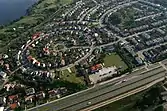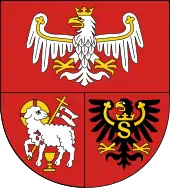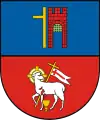Olsztyn
Olsztyn (UK: /ˈɒlʃtɪn/ OL-shtin,[2] Polish: [ˈɔlʂtɨn] (![]() listen); German: Allenstein [ˈʔalənʃtaɪn] (
listen); German: Allenstein [ˈʔalənʃtaɪn] (![]() listen); Old Polish: Holstin; Old Prussian: Alnāsteini or Alnestabs; Lithuanian: Olštynas) is a city on the Łyna River in northeastern Poland. Olsztyn is the capital of the Warmian-Masurian Voivodeship, and is a city with county rights. The population of the city was estimated at 171,979 residents in 2019.[1]
listen); Old Polish: Holstin; Old Prussian: Alnāsteini or Alnestabs; Lithuanian: Olštynas) is a city on the Łyna River in northeastern Poland. Olsztyn is the capital of the Warmian-Masurian Voivodeship, and is a city with county rights. The population of the city was estimated at 171,979 residents in 2019.[1]
Olsztyn | |
|---|---|
 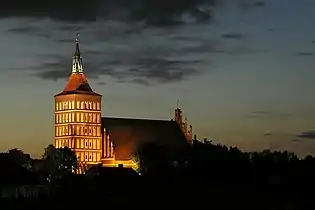 .jpg.webp) 
| |
 Flag  Coat of arms | |
| Motto(s): Olsztyn – Miasto Młode Duchem… (Olsztyn – a city young in spirit…) | |
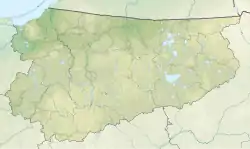 Olsztyn  Olsztyn | |
| Coordinates: 53°46′40″N 20°28′45″E | |
| Country | |
| Voivodeship | |
| County | city county |
| Established | 14th century |
| Town rights | 1353 |
| Government | |
| • Mayor | Piotr Grzymowicz |
| Area | |
| • City | 88.328 km2 (34.104 sq mi) |
| Highest elevation | 154 m (505 ft) |
| Lowest elevation | 88 m (289 ft) |
| Population (31 December 2019) | |
| • City | 171,979 |
| • Density | 1,950/km2 (5,100/sq mi) |
| • Metro | 270,000 |
| Time zone | UTC+1 (CET) |
| • Summer (DST) | UTC+2 (CEST) |
| Postal code | 10-001 to 11–041 |
| Area code(s) | +48 89 |
| Car plates | NO |
| Climate | Dfb |
| Website | http://www.olsztyn.eu |
Founded as Allenstein in the 14th century, Olsztyn was under the control and influence of the Teutonic Order until 1463, when it passed to the Polish Crown, what was then confirmed in the Second Peace of Thorn in 1466.[3] For centuries the city was an important centre of trade, crafts, science and administration in the Warmia region linking Warsaw with Königsberg.[4] Following the First Partition of Poland in 1772 Warmia was annexed by Prussia and ceased to be the property of the clergy. In the 19th century the city changed its status completely, becoming the most prominent economic hub of the southern part of Eastern Prussia. The construction of a railway and early industrialisation greatly contributed to Olsztyn's significance. Following World War II, the city returned to Poland in accordance with the Potsdam Agreement.
Olsztyn is the largest city in Warmia, and since 1999 it has been the capital city of the Warmian-Masurian Voivodeship. In the same year, the University of Warmia and Masuria was founded from the fusion of three other local universities. Today, the Castle of Warmian Bishops houses a museum and is a venue for concerts, art exhibitions, film shows and other cultural events, which make Olsztyn a popular tourist destination.[5][6]
The most important sights of the city include the medieval Old Town and the Olsztyn Cathedral, which dates back more than 600 years. The picturesque market square is part of the European Route of Brick Gothic and the cathedral is regarded as one of the greatest monuments of Gothic architecture in Poland.[7]
Olsztyn, for a number of years, has been ranked very highly in quality of life, income, employment and safety. It currently is one of the best places in Poland to live and work.[8][9] It is also one of the happiest cities in the country.[9]
History
![]() Kingdom of Poland 1454–1455
Kingdom of Poland 1454–1455
![]() Teutonic Order 1455–1463
Teutonic Order 1455–1463
![]() Kingdom of Poland 1463–1569
Kingdom of Poland 1463–1569
![]() Polish–Lithuanian Commonwealth 1569–1772
Polish–Lithuanian Commonwealth 1569–1772
![]() Kingdom of Prussia 1772–1871
Kingdom of Prussia 1772–1871
![]() German Empire 1871–1918
German Empire 1871–1918
![]() Weimar Germany 1918–1933
Weimar Germany 1918–1933
![]() Nazi Germany 1933–1945
Nazi Germany 1933–1945
![]() People's Republic of Poland 1945–1989
People's Republic of Poland 1945–1989
Middle Ages

In 1334, a watchtower was established on the Łyna River. In 1346, the forest was cleared at the location for a new settlement, mentioned in a historical document from 1348.[10] The following year, Teutonic Knights began the construction of an Ordensburg castle as a stronghold against the Baltic Prussians.[11] Allenstein was granted municipal rights by the cathedral chapter of the Bishopric of Warmia in October 1353.[11][12] The German "Allenstein" referred to the river's Baltic Prussian name Alna, which meant a hind.[13] Local Poles, having arrived along with German settlers, called it Holstin and Olsztyn,[11] which are Polonizations of the German name. The castle was completed in 1397.[13] The town was captured by the Kingdom of Poland during the Polish-Lithuanian-Teutonic War in 1410, and again in 1414 during the Hunger War, but it was returned to the monastic state of the Teutonic Knights after hostilities ended.
The city joined the Prussian Confederation in 1440 and rebelled against the Teutonic Knights in 1454 upon the outbreak of the Thirteen Years' War to join Poland under King Casimir IV Jagiellon. The townspeople took the castle and recognized the Polish king as the rightful ruler.[13] Although the Teutonic Knights recaptured the city the following year, it was retaken by Polish troops in 1463.[14] The Second Peace of Thorn in 1466 confirmed Olsztyn as part of the Kingdom of Poland.[15] Administratively it was located in the Prince-Bishopric of Warmia within the provinces of Royal Prussia and Greater Poland.
Modern era
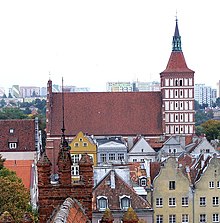
From 1516 to 1521, Nicolaus Copernicus lived at the town's castle as administrator and in Mehlsack (Melzak, now Pieniężno). Copernicus was in charge of the Polish defenses in the Siege of Allenstein during the Polish-Teutonic War of 1519–21.[16] He also started and managed the repopulation of the region, inviting a new wave of Polish settlers from Mazovia.[13] The town along with Warmia then entered what is considered the region's golden age,[14] crafts and trade developed, also due to the city's location on the Warsaw-Königsberg (Królewiec) trade route.[13] During this period, the city was still visited several times by Copernicus, as well as leading figures of Polish Renaissance, writers, royal secretaries and diplomats: Johannes Dantiscus, called the "father of Polish diplomacy", and Marcin Kromer, who was also a historian and music theorist. The St. James' Cathedral, one of the most distinctive landmarks of the cityscape, was completed.[15]
Prosperity was halted in the 1620s, when the town suffered a fire[15] and an epidemic.[14] In 1626, during the Swedish invasion, canons from Frombork (Frauenburg) took refuge in the town, which the Swedes did not reach.[14] The city was sacked by Swedish troops later, in 1655 and 1708, during the next Polish-Swedish wars, and its population was nearly wiped out in 1710 by epidemics of bubonic plague and cholera.
The town became part of the Kingdom of Prussia in 1772 after the First Partition of Poland and its economy initially collapsed.[10] Poles became subject to extensive Germanisation policies. A Prussian census recorded a population of 1,770 people, predominantly farmers, and Allenstein was administered within the newly created Province of East Prussia. It was visited by Napoleon Bonaparte[17] in 1807 after his victories over the Prussian Army at Jena and Auerstedt. The growth of the city started again after it became a district seat in 1818,[14] a significant influx of German settlers began and by 1825, the town was inhabited by 1,341 Germans and 1,266 Poles.[18] In the early 1830s the city suffered from a cholera epidemic and a hunger crisis, however afterwards it flourished again, when despite Germanisation policies it was administered by Polish mayor Jakub Rarkowski from 1836 to 1865.[14][19] Under Rarkowski the city was expanded and modernized,[14] and the mayor also hid Polish insurgents in the city during the January Uprising.[19] The first German-language newspaper, the Allensteiner Zeitung, began publishing in 1841. Polish historian Wojciech Kętrzyński was arrested in Jomendorf (the present-day district of Jaroty),[14] and imprisoned in the city's High Gate in 1863 for smuggling weapons for the Polish January Uprising in the Russian Partition of Poland.[20] The town hospital was founded in 1867.

In 1871, with the unification of Germany, Allenstein became part of the German Empire. Two years later, the city was connected by railway to Thorn (Toruń). Despite Germanisation attempts the city remained an important Polish centre.[10] Its first Polish language newspaper, the Gazeta Olsztyńska, was founded in 1886.[15] Allenstein's infrastructure developed[21] rapidly: gas was installed in 1890, telephones in 1892, public water supply in 1898, and electricity in 1907. The Provincial Mental Sanatorium Kortau was established in 1886 just south of Allenstein (today part of Olsztyn-Kortowo). In 1905, the city became the capital of Regierungsbezirk Allenstein, a government administrative region in East Prussia. From 1818 to 1910, the city was administered within the East Prussian Allenstein District, after which it became an independent city.
World War I, interbellum and World War II
_-_16.04.1917.jpg.webp)
.jpg.webp)
Shortly after the outbreak of World War I in 1914, Russian troops captured Allenstein, but it was recovered by the Imperial German Army in the Battle of Tannenberg.
After the defeat of Germany in World War I, the East Prussian plebiscite was held in 1920 to determine whether the populace of the region, including Allenstein, wished to remain in German East Prussia or become part of Poland, which had just regained independence. In order to advertise the plebiscite, special postage stamps were produced by overprinting German stamps and sold on 3 April of that year. One kind of overprint read PLÉBISCITE / OLSZTYN / ALLENSTEIN, while the other read TRAITÉ / DE / VERSAILLES / ART. 94 et 95 inside an oval whose border gave the full name of the plebiscite commission. Each overprint was applied to 14 denominations ranging from 5 Pfennigs to 3 Marks. The Polish community faced discrimination, Polish rallies were dispersed, the participants were threatened and beaten.[14] In March, Polish activist Bogumił Linka died in Olsztyn, a few weeks after being brutally beaten by the German militia in nearby Szczytno in Masuria.[22][23][24] He was buried in Olsztyn, however, his grave was soon devastated by local German nationalists.[22][23][25] A monument to Linka was unveiled after Poland regained control of the city after World War II.[22][23] The presence of a Royal Irish battalion ensured a relative peace in Allenstein.[26] The plebiscite, held on 11 July, produced 16,742 votes for Germany and 342 votes for Poland.[14]

In the interwar period, numerous Polish organisations operated in the city, including the Polish Scouting and Guiding Association, Union of Poles in Germany, a People's Bank (Bank Ludowy),[10] local Poles organised a school, library, puppet theatre.[14] The Polish Consulate also operated. After the January 1933 Nazi seizure of power in Germany, Poles and Jews in Allenstein were increasingly persecuted.[14] In 1935, the German Wehrmacht made the city the seat of the Allenstein Militärische Bereich. It was then home of the 11th and 217th infantry divisions and 11th Artillery Regiment. At the same time, the football club SV Hindenburg Allenstein played in Allenstein from 1921 to 1945.
Beginning in 1936, members of the Polish minority was increasingly persecuted, especially members of the Union of Poles in Germany.[14] In early 1939, many local Polish activists were expelled.[27] In an attempt to rig the results of an upcoming census and understate the number of Poles in the city and region, the Germans terrorized the Polish population and, in May 1939, the Gestapo confiscated 10,000 Polish information leaflets in the headquarters of the Gazeta Olsztyńska.[28] In August 1939, Germany introduced martial law in the region, which allowed for even more blatant persecution of Poles.[29] In August and September 1939, the Germans carried out mass arrests of local Poles, including the chairman of the local Polish bank and his assistant, the chief of the "Rolnik" Cooperative,[30] and the principal of the local Polish school.[31]
Nazi Germany co-formed the Einsatzgruppe V in the city, which then entered several Polish cities and towns, including Grudziądz, Mława, Ciechanów, Łomża and Siedlce, to commit various atrocities against Poles during the German invasion of Poland that began World War II in 1939.[32] German troops invaded Poland also from Olsztyn.[3] After the German invasion of Poland, local Poles were also subjected to mass executions[10] and deportations to occupied Poland. Arrested Poles were held in a local prison and then forced to remove Polish signs and inscriptions in the city, while the German population gathered and insulted them.[33] The Gazeta Olsztyńska was abolished by the German authorities, the newspaper's headquarters was demolished and the editor-in-chief Seweryn Pieniężny was arrested and executed in the KZ Hohenbruch[14][3] along with co-publisher Wojciech Gałęziewski and the "Rolnik" Cooperative chief Leon Włodarczyk, while Pieniężny's wife was deported to the Ravensbrück concentration camp.[34] The last pre-war Polish consul in Allenstein, Bohdan Jałowiecki, along with the consulate staff, was imprisoned in the Hohenbruch and Soldau concentration camps,[35] and then murdered.[36] Polish teachers were deported to the Dachau concentration camp.[34]

During the war five forced labour camps were established in the city.[10] On 12 October 1939, the Wehrmacht established an Area Headquarters for a military district that controlled the environs of Allenstein, including Lötzen (now Giżycko), and Ciechanów in occupied Poland. As part of the Aktion T4, Nazi Germany conducted medical experiments on the patients of the psychiatric hospital in the present-day district of Kortowo, in which at least 5,000 people were killed.[37]
On 22 January 1945, near the end of the war, Allenstein was plundered and burned by the conquering Soviet Red Army, and much of its German population fled.[38] The remaining, mostly Polish population, was subjected to various crimes, including murder, rape and looting.[3][14] The Soviets also murdered the remaining patients and staff of the psychiatric hospital, who were either burned alive or shot.[37] On 23 May 1945, Olsztyn became again part of Poland under border changes promulgated at the Potsdam Conference. In October 1945, the remaining German population was expelled, to be replaced by new Polish settlers,[39] mostly those expelled from pre-war Polish regions of Vilnius, Grodno and Volhynia, annexed by the Soviet Union, as well as settlers from Warsaw destroyed by the Germans.[14] Reconstruction and removal of damages lasted until the 1950s.
Contemporary history
In December 1945, a match factory was launched in Olsztyn, as the city's first post-war industrial plant of national importance.[40] A tyre factory was founded in Olsztyn in 1967. Its subsequent names included OZOS, Stomil and Michelin.[41] City limits were greatly expanded in 1966 and 1987.[3]
On the 500th anniversary of the birth of Nicolaus Copernicus, in 1973, a planetarium was opened in Olsztyn.[15] In 1989 the former Gazeta Olsztyńska headquarters was rebuilt and re-opened as a museum. In 1991 Pope John Paul II visited the city.[15] In 1999 the University of Warmia and Mazury in Olsztyn was established, which is now one of the largest universities in northeastern Poland.
Olsztyn became the capital of the Warmian-Masurian Voivodeship in 1999. It was previously in the Olsztyn Voivodeship.
Olsztyn Castle
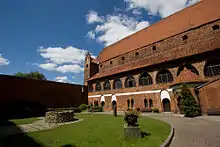
The castle was built between 1346–1353 and by then it had one wing on the north-east side of the rectangular courtyard. Access to the castle lead from the drawbridge over the river Łyna, surrounded by a belt of defensive walls and a moat. The south-west wing of the castle was built in the 15th century, the tower situated in the west corner of the courtyard, from the middle of the 14th century, was rebuilt in the early 16th century and had a round shape on a square base and was 40 meters high. At the same time the castle walls were raised to a height of 12 meters and a second belt of the lower walls was built. The castle walls were partly combined with city walls, which made the castle look like it had been a powerful bastion defending access to the city. The castle was owned by Warmia Chapter, which until 1454, together with the Prince-Bishopric of Warmia, was under military protection of the Teutonic Knights and their Monastic State of Prussia.

The castle had played a huge role in the Polish-Teutonic wars by then. After the Battle of Grunwald in 1410, the Poles took it after a few days siege. In the Thirteen Years' War (1454–66) it was jumping from rule to rule. The Knights threatened the castle and the town in 1521, but the defence was very effective. They contained one failed assault. There is a connection between the history of the castle, the city of Olsztyn, and Nicolaus Copernicus. He prepared the defence of Olsztyn against the invasion of the Teutonic Knights.
In the sixteenth century, there were two prince-bishops of Warmia that stayed there: Johannes Dantiscus – the first sarmatian poet, endowed with the imperial laurel wreath for "Latin Songs" (1538, 1541) and Marcin Kromer, who wrote with equal ease in Latin and Polish scientific and literary works (1580). Kromer consecrated the chapel of St. Anna, which was built in the south-west wing of the castle. In the course of time both wings of the castle lost military importance, which for residential purposes has become very convenient. In 1779 Prince-Bishop Ignacy Krasicki stopped here as well.
After the Prussian annexation of Warmia during the First Partition of Poland in 1772, the castle became the property of the state board of estates (War and Domain Chamber, Kriegs- und Domänenkammer). In 1845 the bridge over the moat was replaced by a dam better connecting the castle with the city. In 1901–1911 a general renovation of the castle was performed, however several sections of the building were violated at the same time where they changed the original look of the castle e.g. putting on window frames in a cloister. The tower was crowned in 1921 and again in 1926 in the halls of the castle, became a museum.
In 1945 the whole castle became home to the Masurian Museum, which today is called the Museum of Warmia and Masuria. In addition there are also popular events held within the frameworks of the Olsztyn Artistic Summer and so called "evenings of the castle" and "Sundays in the Museum".
Jewish community
Though Jews did trade in the city fairs during medieval times, they were not allowed to trade freely in the villages surrounding the city.[42] In 1718, Bishop Teodor Andrzej Potocki imposed a ban on Jewish trade.[43] Other bishops after him continued the ban, which apparently wasn't successful since the city population complained about Jews dealing with animal leather and other products in 1742. Permanent Jews were found in the city in 1780, and they were allowed to settle outside the city walls.[44] In 1814, the Simonson brothers opened the first Jewish store in town. In 1850, the city official authority announced that any citizen that hosted a wandering Jew in his house, would be fined and imprisoned.[45]

The Jewish community of the city as a congregation was established in 1820. Shortly after, a prayer room was established on Richterstrasse. In 1877, the congregation bought a plot of land on Liebstädterstrasse and built a synagogue there.[46] A Jewish cemetery was built on Seestrasse (present-day Grundwalzka). While at its peak, the town's Jewish population was 448 Jews in 1933.
On Kristallnacht, the town synagogue was destroyed and later used as a bomb shelter.[47] Now, a sports club sits on the site of the synagogue.[48]
By 1939, 135 Jews were left in the city, after most others fled from the country. Those who lived in town in 1940 were deported to Nazi concentration camps.[49] In June 1946, 16 Holocaust survivors settled in the city and in 1948, the congregation had 190 worshipers. Most of them emigrated to Israel throughout the next few decades. There is no current trace of the Jewish cemetery.[50]
The city was the birthplace of world-famous Jewish architect Erich Mendelsohn. In town, Mendelsohn planned the mourners' chapel (called the Mendelsohn house) next to the cemetery.[51] The building is currently restored.[52] In addition, it was the birthplace of German Socialist and SPD leader Hugo Haase. Frieda Strohmberg, an Impressionist, lived and worked in the city from 1910 to 1927. Documentation of the Jewish owned shops in town exists.[53]
Geography


Olsztyn is located in the north-east part of Poland in the region known as the "Thousand Lakes".
Greenbelt
More than half of the forests occupying 21.2% of the city area form a single complex of the Municipal Forest (1050 ha) used mainly for recreation and tourism purposes. Within the Municipal Forest area are situated two peat-land flora sanctuaries, Mszar and Redykajny. Municipal greenery (560 ha, 6.5% of the town area) developed in the form of numerous parks, green spots and three cemeteries over a century-old. The greenery includes 910 monuments of nature and groups of protected trees in the form of beech, oak, maple and lime-lined avenues.
Lakes
The city is situated in a lake region of forests and plains. There are 15 lakes inside the administrative bounds of the city (13 with areas greater than 1 ha). The overall area of lakes in Olsztyn is about 725 ha, which constitutes 8.25% of the total city area.
| Lake | Area (ha) | Maximum depth (m) |
|---|---|---|
| Lake Ukiel (a.k.a. Jezioro Krzywe) | 412 | 43 |
| Lake Kortowskie | 89.7 | 17.2 |
| Lake Track (a.k.a. Trackie) | 52.8 | 4.6 |
| Lake Skanda | 51.5 | 12 |
| Lake Redykajny | 29.9 | 20.6 |
| Lake Długie | 26.8 | 17.2 |
| Lake Sukiel | 20.8 | 25 |
| Lake Tyrsko | 18.6 | 30.6 |
| Lake Stary Dwór | 6.0 | 23.3 |
| Lake Siginek | 6.0 | insufficient data |
| Lake Czarne | approximately 1.3 | insufficient data |
| Lake Żbik | approximately 1.2 | insufficient data |
| Lake Pereszkowo | approximately 1.2 | insufficient data |
| Lake Mummel | approximately 0.3 | insufficient data |
| Lake Modrzewiowe | 0.25 | insufficient data |
Demographics

Administrative division

Olsztyn is divided into 23 districts:
| District | Population | Area | Density |
|---|---|---|---|
| Brzeziny | 1,456 | 2.25 km2 (0.87 sq mi) | 647.1/km2 |
| Dajtki | 5,863 | 7.5 km2 (2.9 sq mi) | 781.7/km2 |
| Generałów | 6,500 | no data | no data |
| Grunwaldzkie | 6,027 | 1.46 km2 (0.56 sq mi) | 4,128.1/km2 |
| Gutkowo | 2,256 | 7.2 km2 (2.8 sq mi) | 313.3/km2 |
| Jaroty | 29,046 | 4.82 km2 (1.86 sq mi) | 6,026.1/km2 |
| Kętrzyńskiego | 7,621 | 4.83 km2 (1.86 sq mi) | 1,577.8/km2 |
| Kormoran | 16,166 | 1.1 km2 (0.4 sq mi) | 14,696.4/km2 |
| Kortowo | 1,131 | 4.22 km2 (1.63 sq mi) | 268/km2 |
| Kościuszki | 6,704 | 1.18 km2 (0.46 sq mi) | 5,681.4/km2 |
| Likusy | 2,286 | 2.1 km2 (0.8 sq mi) | 1,088.6/km2 |
| Mazurskie | 4,615 | 5.98 km2 (2.31 sq mi) | 771.7/km2 |
| Nad Jeziorem Długim | 2,408 | 4.23 km2 (2 sq mi) | 569.3/km2 |
| Nagórki | 12,538 | 1.69 km2 (0.65 sq mi) | 7,418.9/km2 |
| Pieczewo | 10,918 | 2.24 km2 (0.86 sq mi) | 4,874.1/km2 |
| Podgrodzie | 11,080 | 1.35 km2 (0.52 sq mi) | 8,207.4/km2 |
| Podleśna | 10,414 | 9.93 km2 (3.83 sq mi) | 1,048.7/km2 |
| Pojezierze | 13,001 | 2.39 km2 (0.92 sq mi) | 5,439.7/km2 |
| Redykajny | 1,555 | 6.1 km2 (2.36 sq mi) | 254.9/km2 |
| Śródmieście | 3,448 | 0.58 km2 (0.22 sq mi) | 5,944.8/km2 |
| Wojska Polskiego | 6,759 | 5.03 km2 (2 sq mi) | 1,343.7/km2 |
| Zatorze | 6,988 | 0.45 km2 (0.17 sq mi) | 15,528.9/km2 |
| Zielona Górka | 1,015 | 6.44 km2 (2.49 sq mi) | 157.6/km2 |
There are many smaller districts: Jakubowo, Karolin, Kolonia Jaroty, Kortowo II, Łupstych, Niedźwiedź, Piękna Góra, Podlesie, Pozorty, Skarbówka Poszmanówka, Słoneczny Stok, Stare Kieźliny, Stare Miasto, Stare Zalbki, Stary Dwór, Track. These do not have council representative assemblies.
Culture


Theatres
- Stefan Jaracz Theatre (est. 1925) the host of International Theatre Festival DEMOLUDY
- Puppet Theatre
Cinemas
- Helios
- Multikino
Museums
- Museum of Warmia and Mazury (Muzeum Warmii i Mazur) – Olsztyn's largest museum.
- Gazeta Olsztyńska House (Dom "Gazety Olsztyńskiej")
- Museum of Nature (Muzeum Przyrody)
- Museum of Sports (Muzeum Sportu)
- Muzeum Nowoczesności
Architecture
.jpg.webp)
The historic central district of Olsztyn is the Old Town (Stare Miasto), which contains various historic buildings and structures, including:
- the Gothic castle of Warmian Bishops, built during the 14th century, former home of Nicolaus Copernicus, now a museum
- Gothic St. James' Cathedral with Gothic-Renaissance-Baroque interior
- Old Town Hall on the Market Square – built in the mid-14th century.
- Gazeta Olsztyńska House at the Targ Rybny ("Fish Market"), now a museum.
- the town walls and the High Gate (until the mid-19th century known as the Upper Gate).
- Our Lady Queen of Poland church
- Monument to Nicolaus Copernicus
- Park Zamkowy (Castle Park)
- Baroque Archpresbyter's Palace (Pałac Archiprezbitera)
- Gothic Revival Church of the Salvator
Notable structures outside of the Old Town include:
- the New City Hall
- the astronomical observatory
- the Jerusalem Chapel, built in 1565
- Neogothic Sacred Heart church, built during the years 1901–1902
- Church of St. Lawrence in the Gutkowo district, built in the late 14th century
- Home Army and Stefan Jaracz monuments and the White Eagle Column
- the Railway Bridge over the River Łyna gorge near Artyleryjska and Wyzwolenia streets, built during the years 1872–1873
- Main Post Office
- Warmian-Masurian Voivodeship office
- Instytut Północny im. Wojciecha Kętrzyńskiego ("Wojciech Kętrzyński Northern Institute")
- Park Centralny (Central Park)
- the Książnica Polska building with one of the oldest active passenger elevators in Poland and Europe
- FM- and TV-mast Olsztyn-Pieczewo – 360 metres high, since the collapse of the Warsaw radio mast the tallest structure in Poland
 High Gate
High Gate Our Lady Queen of Poland Church
Our Lady Queen of Poland Church New City Hall
New City Hall Astronomical observatory
Astronomical observatory Jerusalem Chapel
Jerusalem Chapel Sacred Heart church
Sacred Heart church Voivodeship office
Voivodeship office
Music
Death metal act Vader, regarded as one of the first and most successful death metal bands from Poland.
Economy

The Michelin tyre company (former Stomil Olsztyn) is the largest employer in the region of Warmia and Masuria.[54] Other important industries are food processing and furniture manufacturing.
Transportation
Bus
Currently a bus network with 36 bus lines exists, including 6 suburban lines and 2 night-time lines.[55]
Trolleybus
In 1939, due to poor economic situation throughout the interwar period and city's growing population, a trolleybus line began operation, partially replacing the original tram network. Olsztyn was a third city in Poland having this method of transportation at that time. During the Second World War the cars were mainly driven by women.
The trolleybus network consisting of 4 lines was decommissioned on 31 July 1971.[56]
Rail
Olsztyn has train connections to Warsaw, Gdańsk, Szczecin, Poznań, Bydgoszcz, Iława, Działdowo and Ełk. Olsztyn Główny is the main railway station in the city. Plans exist to demolish current building and replace it with new infrastructure,[57] contrary to previous information about current building being renovated.[58]
Tram
.JPG.webp)
Historically, city's first tram line was built in 1907 and gradually expanded over the years. It ceased operation in 1965.[59]
In 2006 authorities considered reintroduction of trams in the city to address transport problems and subsequently concluded feasibility studies on the matter in 2009.[60] A 11 kilometres (7 miles) long tram network was built between 2011 and 2015. The contract was signed in 2011 and construction commenced in 2012.[59] It was a first new tram system built in Poland in 55 years; 15 low-floor Tramino trams were ordered from Solaris in September 2012.[61] There are currently 3 tram lines in operation.[55]
A 6 kilometres (4 miles) long extension is planned and Turkish manufacturer Durmazlar had been selected to supply 24 trams for the network.[62]
Education

Sports

- Indykpol AZS Olsztyn – men's volleyball team playing in the Polish Volleyball League (PLS, Polska Liga Siatkówki), five time Polish champions
- Stomil Olsztyn – men's football team, playing in the I liga (second tier). It played in the Ekstraklasa, the country's top flight, from 1994 to 2002.
- Warmia Olsztyn – men's handball team playing in the I liga (second tier). It played in the Superliga, the country's top flight, most recently from 2005 to 2012.
- Warmia Olsztyn – one of the oldest football clubs in the city, currently playing in the lower leagues. It played on the second tier, most recently in the 1990s
- AZS UWM Trójeczka Olsztyn – men's basketball team playing in the Polish Second League
- WMPD Olsztyn – men's rugby team, playing in the First Polish League
- Budowlani Olsztyn – a wrestling team
- Joanna Jędrzejczyk (born 1987), Polish Muay-Thai and MMA fighter, former UFC Women's Strawweight Champion
- Łukasz Gikiewicz (born 1987), Polish footballer
- Rafał Gikiewicz (born 1987), Polish footballer
- Filip Kurto (born 1991), Polish footballer
- Olsztyn Lakers – American football team
The Memorial of Hubert Jerzy Wagner, an international volleyball friendly tournament, was organized in Olsztyn from 2003 to 2008. The Tour de Pologne, one of UCI World Tour races, was organized in Olsztyn numerous times, most recently in 2008 (as of 2019).
Politics
Members of the Sejm elected from Olsztyn constituency in 2005:
- Mieczysław Aszkiełowicz, Self-Defense of the Republic of Poland (Samoobrona Rzeczypospolitej Polskiej)
- Beata Bublewicz, Civic Platform (PO, Platforma Obywatelska)
- Jerzy Gosiewski, Law and Justice (PiS, Prawo i Sprawiedliwość)
- Tadeusz Iwiński, Democratic Left Alliance (SLD, Sojusz Lewicy Demokratycznej)
- Edward Ośko, League of Polish Families (LPR, Liga Polskich Rodzin)
- Adam Puza, Law and Justice (PiS, Prawo i Sprawiedliwość)
- Sławomir Rybicki, Civic Platform (PO, Platforma Obywatelska)
- Lidia Staroń, Civic Platform (PO, Platforma Obywatelska)
- Aleksander Marek Szczygło, Law and Justice (PiS, Prawo i Sprawiedliwość)
- Zbigniew Włodkowski, Polish Peasant Party (PSL, Polskie Stronnictwo Ludowe)
Members of Senate elected from Olsztyn constituency in 2005:
- Ryszard Józef Górecki, Civic Platform (PO, Platforma Obywatelska)
- Jerzy Szmit, Law and Justice (PiS, Prawo i Sprawiedliwość)
Notable residents


- Johannes von Leysen (1310–1388), town founder and mayor
- Nicolaus Copernicus (1473–1543), astronomer, administrator, and town commander
- Johannes Knolleisen (+1511), German academic and provider of academic stipends
- Lucas David (1503–1583), German historian of Prussia
- Marcin Kromer (1512–1589), Polish cartographer, diplomat and historian, personal secretary of Kings of Poland, Bishop of Warmia
- Antoni Blank (1785–1844), Polish painter
- Hugo Haase (1863–1919), Jewish-German politician, jurist and pacifist
- Franz Justus Rarkowski (1873–1950), military bishop (1938–45)
- August Trunz (1875–1963), founder of the Prussica-Sammlung Trunz
- Feliks Nowowiejski (1877–1946), Polish composer, conductor, concert organist
- Maximilian Kaller (1880–1947) German prelate, bishop of Ermland in 1930–45
- Erich Mendelsohn (1887–1953), German-Jewish architect who fled the Nazis
- Olga Desmond (1891–1964), German dancer and actress
- Günter Wand (1912–2002), German conductor
- Kurt Baluses (1914–72) German football (soccer) player and manager
- Herbert Schachtschneider (1919–2008), German operatic tenor
- Hans-Jürgen Wischnewski (1922–2005), German politician
- Curt Lowens (1925–2017), German actor
- Leonhard Pohl (1929–2014), German gymnast
- Józef Glemp (1929–2013), Polish prelate, bishop of Warmia 1979–81
- Jörg Kuebart (1934–2018) German general of the German Air Force
- Karl-Heinz Hopp (1936–2007) German rower who competed in the 1960 Summer Olympics
- Wolf Lepenies (born 1941), German sociologist, political scientist and author
- Eugeniusz Geno Malkowski (1942–2016), Polish artist, painter and academic
- Ulrich Schrade (1943–2009), German-Polish philosopher and pedagogue
- Marian Bublewicz (1950–1993), Polish rally and race driver of the 80s and 90s
- Juliusz Machulski (born 1955), Polish film director
- Izabela Trojanowska (born 1955), Polish actress and singer
- Andrzej Friszke (born 1956), Polish historian
- Krzysztof Hołowczyc (born 1962), Polish rally driver
- Piotr "Peter" Wiwczarek (born 1965), Polish musician, vocalist and lead guitarist of the death metal band Vader
- Artur Wojdat (born 1968), swimmer
- Mamed Khalidov (born 1980), Russian-Polish mixed martial artist
- Wojciech Grzyb (born 1981), Polish volleyball player
- Julia Marcell (born 1982), Polish singer/songwriter and pianist
- Małgorzata Jasińska (born 1984), Polish professional cyclist (retd.)
- Marcin Możdżonek (born 1985), volleyball player
- Adrian Mierzejewski (born 1986), Polish footballer
- Rafał Gikiewicz (born 1987), Polish footballer
- Joanna Jędrzejczyk (born 1987), Muay-Thai and MMA fighter, former UFC Women's Strawweight Champion
- Artur Szalpuk (born 1995), Polish volleyball player, 2018 World Champion
International relations
Twin towns – Sister cities
Olsztyn is twinned with:
|
|
|
Olsztyn belongs to the Federation of Copernicus Cities, an association of cities where Copernicus lived and worked, such as Bologna, Frombork, Kraków, and Toruń. The main office of the federation is situated at Olsztyn Planetarium and Astronomical Observatory, located on St. Andrew's Hill (143 m) in a former water tower erected in 1897.
Notes
- "Local Data Bank". Statistics Poland. Retrieved 26 June 2020. Data for territorial unit 2862000.
- "Olsztyn". Lexico UK Dictionary. Oxford University Press. Retrieved 19 August 2019.
- "The history of Olsztyn". Visit Olsztyn. Retrieved 13 November 2020.
- "Local history – Information about the town – Olsztyn – Virtual Shtetl". Retrieved 17 November 2016.
- o.o., StayPoland Sp. z. "Olsztyn – Tourism – Tourist Information – Olsztyn, Poland -". Retrieved 17 November 2016.
- "Presentation of castle and museum trail, cultural – historical attractions of the Baltic Sea region". Retrieved 17 November 2016.
- Budziłło, Elzbieta. "Olsztyn – Copernicus city with 15 lakes". Retrieved 17 November 2016.
- "W Olsztynie żyje się (prawie) najlepiej. W rankingu miast awansowaliśmy na czwarte miejsce". Retrieved 29 March 2017.
- "Ranking jakości miejskiego życia. W Olsztynie żyje się bardzo dobrze". Retrieved 29 March 2017.
- "Olsztyn". Encyklopedia PWN (in Polish). Retrieved 10 February 2020.
- "Miasto Olsztyn – perła Warmii, największe miasto województwa warmińsko-mazurskiego". Retrieved 17 November 2016.
- "Zabytki Olsztyn Atrakcje Historii Zwiedzanie Miasta w Centrum". Retrieved 17 November 2016.
- "Historia" (in Polish). Retrieved 17 November 2016.
- "Historia Olsztyna". atrakcje.Olsztyn.pl (in Polish). Retrieved 10 February 2020.
- "Historia Olsztyna" (in Polish). Retrieved 29 March 2017.
- Höhne, Manfred. "Historia Olsztyna – Prusy Wschodnie". Retrieved 17 November 2016.
- "Historia Olsztyna – Castles of Poland". Retrieved 17 November 2016.
- Historia Pomorza: (1815–1850), Gerard Labuda, Poznańskie Towarzystwo Przyjaciół Nauk, page 157, 1993
- "Rocznica śmierci burmistrza Olsztyna, Jakuba Rarkowskiego". Kultura.wm.pl (in Polish). Retrieved 26 March 2020.
- "Wojciech Kętrzyński". Atrakcje turystyczne Olsztyna (in Polish). Retrieved 26 March 2020.
- "Olsztyn – Gołębnik w środku miasta. Atrakcje turystyczne Olsztyna. Ciekawe miejsca Olsztyna". Retrieved 17 November 2016.
- "90–lecie śmierci Bogumiła Linki". Olsztyn24 (in Polish). Retrieved 26 March 2020.
- "Pamięci Bogumiła Linki w rocznicę śmierci". Gazeta Wyborcza (in Polish). Retrieved 26 March 2020.
- Piotr Stawecki Warmiacy i Mazurzy - kawalerowie Krzyża i Medalu Niepodległosci Komunikaty Mazursko-Warmińskie issue 2-3, page 309
- Bogumil Linka PWN Encyclopedia
- Williamson, David G. (2017). The British in interwar Germany. London, New York: Bloomsbury Academic. p. 78. ISBN 978-1-4725-9582-9.
- Cygański, Mirosław (1984). "Hitlerowskie prześladowania przywódców i aktywu Związków Polaków w Niemczech w latach 1939-1945". Przegląd Zachodni (in Polish) (4): 38.
- Cygański, p. 39
- Cygański, p. 40
- Wardzyńska, Maria (2003). "„Intelligenzaktion" na Warmii, Mazurach i północnym Mazowszu". Biuletyn Instytutu Pamięci Narodowej (in Polish). No. 12-1 (35-36). IPN. p. 39. ISSN 1641-9561.
- Cygański, p. 42
- Wardzyńska, Maria (2009). Był rok 1939. Operacja niemieckiej policji bezpieczeństwa w Polsce. Intelligenzaktion (in Polish). Warszawa: IPN. p. 54.
- Wardzyńska (2009), p. 77
- Wardzyńska (2003), p. 41
- Wardzyńska (2009), p. 228
- Cygański, p. 60
- "Dzisiaj mija 74. rocznica rzezi w Kortowie. Sowieckie oddziały zamordowały około 600 osób". Radio Olsztyn (in Polish). Retrieved 29 December 2020.
- "Olsztyn – Barwna historia miasta – Zabawa.Mazury.pl". Retrieved 17 November 2016.
- joanna. "Historia lokalna – Olsztyn rok 1945 i pierwsze lata powojenne". Retrieved 17 November 2016.
- Wiadomości Mazurskie, 4 (40), 1945, p. 3 (in Polish)
- e.V., Christoph Pienkoss, DV – Deutscher Verband für Städtebau und Wohnungswesen. "EuRoB – Europäische Route der Backsteingotik – Strona internetowa – Miasta nad Szlaku – Polska – Olsztyn – Historia miasta". Retrieved 17 November 2016.
- W. Knercer, Cmentarze i zabytki kultury żydowskiej w województwie olsztyńskim, "Borussia", no. 6, 1993, p. 53; vide K. Forstreuter, Die ersten Juden in Ostpreussen, "Altpreussische Forschungen", ch. 14, 1937, pp. 42–48.
- "History – Jewish community before 1989 – Olsztyn – Virtual Shtetl". Archived from the original on 1 January 2014. Retrieved 17 November 2016.
- J. Jasiński, Olsztyn w latach 1772 – 1918, in: Olsztyn "1353 – 2003, ed. S. Achremczyk, W. Ogrodziński, Olsztyn 2003, p. 228.
- J. Jasiński, Olsztyn w latach 1772 – 1918, in: Olsztyn 1353 – 2003, ed. S. Achremczyk, W. Ogrodziński, Olsztyn 2003, p. 229.
- "Old synagogue – Synagogues, prayer houses and others – Heritage Sites – Olsztyn – Virtual Shtetl". Retrieved 17 November 2016.
- "Archive – east-prussia – Allenstein". Retrieved 17 November 2016.
- "Jewish culture in Olsztyn – Virtual Shtetl". Retrieved 17 November 2016.
- https://www.bundesarchiv.de/gedenkbuch/directory.html#frmResults (matches for "Allenstein", with marked: "Wohnort" and "Geburtsort"; (as of 25 March 2009); http://www.yadvashem.org/wps/portal/!ut/p/_s.7_0_A/7_0_2KE?next_form=advanced_search (people living in Olsztyn before the war – matches for "Allenstein", with marked: "Before the War", (as of 25 March 2009); http://www.yadvashem.org/wps/portal/!ut/p/_s.7_0_A/7_0_2KE?next_form=advanced_search (people born in Olsztyn – matches for "Allenstein", with marked: "Birth"; (as of 25 March 2009).
- "Jewish Cemetery (Zyndrama z Maszkowic Street) – Cemeteries – Heritage Sites – Olsztyn – Virtual Shtetl". Retrieved 17 November 2016.
- "Family House of Erich Mendelsohn – 21 Podgórna Street (Oberstrasse, today's 10 Staromiejska) – Heritage sites – Heritage Sites – Olsztyn – Virtual Shtetl". Archived from the original on 1 January 2014. Retrieved 17 November 2016.
- "Mendelsohn's house will be renovated – Virtual Shtetl". Retrieved 17 November 2016.
- "History – Jewish community before 1989 – Olsztyn – Virtual Shtetl". Archived from the original on 1 January 2014. Retrieved 17 November 2016.
- "100-milionowa opona w olsztyńskiej fabryce Michelin – Autoflesz.pl – Niezależny Portal Motoryzacyjny". Autoflesz.pl. Archived from the original on 21 May 2014. Retrieved 16 September 2011.
- "Schematy Komunikacyjne". ZDZiT - Zarząd Dróg Zieleni i Transportu w Olsztynie (in Polish). Retrieved 3 February 2019.
- Janduła, Martyn (6 March 2016). "Trolejbusowe szaleństwo Olsztyna". Transport-Publiczny.pl (in Polish). Retrieved 3 February 2019.
- Kurs, Tomasz (2 February 2019). "Tajemnicza układanka, czyli jak będzie wyglądał Olsztyn Główny". olsztyn.wyborcza.pl (in Polish). Retrieved 3 February 2019.
- Urbanowicz, Witold (6 November 2017). "Rusza przetarg na projekt budowy nowego Olsztyna Głównego". Transport-Publiczny.pl (in Polish).
- "Trams return to Olsztyn after 50 years". www.tautonline.com. 27 April 2016. Retrieved 3 February 2019.
- "Olsztyn city reintroduces trams". Railway PRO Communication Platform. 13 January 2016. Retrieved 3 February 2019.
- "Solaris to deliver 15 Tramino low-floor trams to Olsztyn". www.breakingtravelnews.com. 1 October 2012. Retrieved 3 February 2019.
- "Durmazlar to supply trams to Olsztyn". Metro Report International. 17 May 2018. Retrieved 3 February 2019.
- "Transportation". Olsztyn-Mazury Airport. Retrieved 3 February 2019.
- Universitx website
- "Le service municipal des jumelages" [Châteauroux municipal twinning service]. Ville de Châteauroux (in French). Archived from the original on 20 September 2012. Retrieved 4 August 2013.
- "List of Twin Towns in the Ruhr District" (PDF). Twins2010.com. Archived from the original (PDF) on 28 November 2009. Retrieved 28 October 2009.
- "Bielsko-Biała – Partner Cities". 2008 Urzędu Miejskiego w Bielsku-Białej. Retrieved 10 December 2008.
- "Weifang". Urząd Miasta Olsztyna. Retrieved 26 March 2020.
References
External links
| Wikimedia Commons has media related to Olsztyn. |
.jpg.webp)
.jpg.webp)

